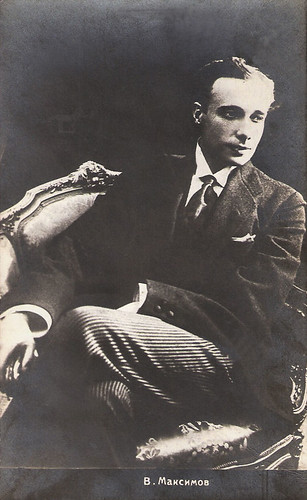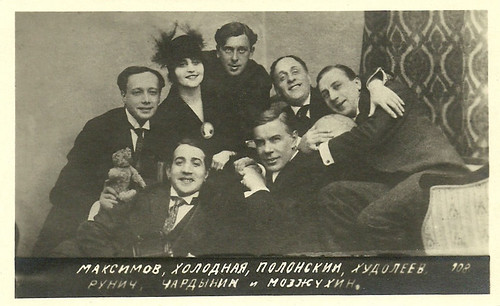Elegant Vladimir Maksimov (1880-1937) was one of the most popular film stars of the Russian empire. After the revolution he became known known for the Soviet films Skorb beskonechnaya / Infinite Sorrow (Aleksandr Panteleyev, 1922), Katsi katsistvis mgelia / Man Is Enemy (Ivane Perestiani, 1923) and Dekabristy / The Decembrists (Aleksandr Ivanovsky, 1927).

Russian postcard. Sent by mail in Estonia in 1922.

Russian postcard, no. 93, Moscow, 1917. Design by K.F. Shvachunova.

Russian postcard. Design by K.F. Shvachunova.

Russian postcard. Vladimir Maksimov and Yablochkina in the stage play 'Общирная страна' (A vast country). 'Обширная страна' was staged in the Imperial Moscow Theatre (Malyi Theatre) in the season of 1912-1913. It was based on Arthur Schnitzler's play 'Das weite Land'. Maksimov played the role of Otto.

Russian postcard. Vladimir Maksimov and Vera Kholodnaya in Na altar krasoty / To the Altar of Beauty (Pyotr Chardynin, 1917).
Vladimir Vasilievich Maksimov (Russian: Владимир Васильевич Максимов) was born in Moscow in the Russian Empire in 1880. His mother was a singing teacher.
Maksimov started his stage career in 1904 at the Moscow Art Theatre under the direction of Konstantin Stanislavsky and V. Nemirovich-Danchenko. Among his roles was Konstantin in The Seagull by Anton Chekhov. From 1906 to 1918, he performed at the famous Maly Theatre.
In 1910, he made his film debut opposite Ivan Mozzhukin for the Khanzhonkov production company in V polnoch na kladbishche/At Midnight in the Graveyard (Vasily Goncharov, 1910). In this short silent horror film, two men are betting about who is to visit a Paris cemetery at midnight. The visit turns out to be fatal.
Next, he played for Khanzhonkov in Oborona Sevastopolya / Defence of Sebastopol (Vasili Goncharov, Aleksandr Khanzhonkov, 1911), the first film ever shot by two cameras. Set in 1854-1855, in Sebastopol and Yalta during the Crimean War. Admirals Kornilov (Ivan Mozzhukin) and Nakhimov (Andrej Gromov) organise the defence during the siege of Sebastopol. Both admirals are killed during the battle, and the city of Sebastopol is taken by the alliance of British, French, Sardinian, and Turkish troops.
The legendary feat of Sailor Koshka (N. Semyonov) was staged at the original location. Veterans of the Crimean War of 1854-1855 took part in the film production. With 100 minutes, it was Russia's first full-length feature film. Oborona Sevastopolya/Defence of Sebastopol premiered in 1911 at the Livadia in Yalta, a palace for Tsar Nicholas II, who was the main sponsor of this production.

Russian postcard. Collection: Didier Hanson.

Russian postcard, no. 78. Collection: Didier Hanson.

Russian postcard, no. 144. Collection: Didier Hanson. Vera Kholodnaya and Vladimir Maksimov in Kak oni lgut/How they lie (Vyacheslav Viskovsky, 1917).

Russian postcard. Collection: Didier Hanson. This is probably the final scene of Molchi, grust'... molchi / Still, Sadness... Still... (Pyotr Chardynin, Kharitonov, 1917). The card depicts the final scene where Paola (Vera Kholodnaya) dies, which the Russian press compared to the death of Trilby. She is surrounded on the right by her partner, the musical clown Lorio (Pyotr Chardynin), and by her lover, the painter Volyntsev (Vladimir Maksimov), on the left. In the back, the painter's mother (Olga Rakhmanova). The statues refer to the artist's studio. Only the first part of this film survives. At the time, it was a huge success in Russia.
Till the end of World War I, Vladimir Maksimov starred in many silent films, including the drama Anfisa (Yakov Protazanov, 1912), the German film Das Haus ohne Tür / The House without a Door (Stellan Rye, 1914) with Theodoor Loos, and Peterburgskiye trushchobi / Petersburg Slums (Petr Cardynin a.k.a. Pyotr Chardynin, Vladimir Gardin, Yakov Protazanov, 1915).
Often playing the elegantly dressed, romantic lover, Maksimov became one of the most popular Russian actors of his era. In 1915 and 1917, he also directed some films.
Maksimov was one of the stars in the cast of the silent drama Molchi, grust... molchi/Молчи, грусть...молчи / Be silent, sorrow ... be silent (Petr Cardynin a.k.a. Pyotr Chardynin, 1918) as Volyntsev, an artist, opposite Vera Kholodnaya, Ossip Runitsch and Vitold Polonsky. This film consisted of two parts, but only the first part (44 minutes in length) survives.
After the Russian Revolution, Maksimov appeared in Soviet films like Skorb beskonechnaya / Infinite Sorrow (Aleksandr Panteleyev, 1922), Katsi katsistvis mgelia / Man Is Enemy (Ivane Perestiani, 1923) as Kraev, Slesar i kantsler / Locksmith and Chancellor (Vladimir Gardin, 1923) as the lawyer Frank Frey. His last part was as Alexander in Dekabristy / The Decembrists (Aleksandr Ivanovsky, 1927). From 1919 to 1924, he was also one of the organisers of the Bolshoi Drama Theatre.
From 1924 on, he taught at the Leningrad Institute of Performing Arts. In 1925, the Soviet Union honoured him as 'Artist of the State'. Vladimir Maksimov died in 1937 in Moscow, Soviet Union. He was 56.

Russian-Polish postcard by K Ltd, dated 5-11-1918. Vladimir Maksimov and Vera Kholodnaya in Сказка любви дорогой/Молчи, грусть... молчи / Be Silent, My Sorrow, Be Silent (Piotr Chardynin, 1918).

Russian postcard, no. 108. Collection: Didier Hanson. A Who is Who of the Russian silent cinema. In a circle from left: actor Vladimir Maksimov (with bear), actress Vera Kholodnaya, actor Vitold Polonsky, actor Ivan Khudoleyev, actor Ivan Mozzhukin, actor-director Pyotr Cardynin and actor Ossip Runitsch.

Russian postcard. Collection: Didier Hanson. A Who is Who of the Russian silent cinema. From left to right: Vitold Polonsky, Vladimir Maksimov, Vera Kholodnaya, Ossip Runitsch (in the back), Pyotr Cardynin, Ivan Khudoleyev, and Ivan Mozzhukin.

Russian postcard, no. 8, 1916. Design possibly by K.F. Shvachunova.
Source: Yuri Tsivian (Silent Witnesses: Russian Films 1908-1919), Wikipedia (French, Russian and English), and IMDb.

Russian postcard. Sent by mail in Estonia in 1922.

Russian postcard, no. 93, Moscow, 1917. Design by K.F. Shvachunova.

Russian postcard. Design by K.F. Shvachunova.

Russian postcard. Vladimir Maksimov and Yablochkina in the stage play 'Общирная страна' (A vast country). 'Обширная страна' was staged in the Imperial Moscow Theatre (Malyi Theatre) in the season of 1912-1913. It was based on Arthur Schnitzler's play 'Das weite Land'. Maksimov played the role of Otto.

Russian postcard. Vladimir Maksimov and Vera Kholodnaya in Na altar krasoty / To the Altar of Beauty (Pyotr Chardynin, 1917).
At midnight in the graveyard
Vladimir Vasilievich Maksimov (Russian: Владимир Васильевич Максимов) was born in Moscow in the Russian Empire in 1880. His mother was a singing teacher.
Maksimov started his stage career in 1904 at the Moscow Art Theatre under the direction of Konstantin Stanislavsky and V. Nemirovich-Danchenko. Among his roles was Konstantin in The Seagull by Anton Chekhov. From 1906 to 1918, he performed at the famous Maly Theatre.
In 1910, he made his film debut opposite Ivan Mozzhukin for the Khanzhonkov production company in V polnoch na kladbishche/At Midnight in the Graveyard (Vasily Goncharov, 1910). In this short silent horror film, two men are betting about who is to visit a Paris cemetery at midnight. The visit turns out to be fatal.
Next, he played for Khanzhonkov in Oborona Sevastopolya / Defence of Sebastopol (Vasili Goncharov, Aleksandr Khanzhonkov, 1911), the first film ever shot by two cameras. Set in 1854-1855, in Sebastopol and Yalta during the Crimean War. Admirals Kornilov (Ivan Mozzhukin) and Nakhimov (Andrej Gromov) organise the defence during the siege of Sebastopol. Both admirals are killed during the battle, and the city of Sebastopol is taken by the alliance of British, French, Sardinian, and Turkish troops.
The legendary feat of Sailor Koshka (N. Semyonov) was staged at the original location. Veterans of the Crimean War of 1854-1855 took part in the film production. With 100 minutes, it was Russia's first full-length feature film. Oborona Sevastopolya/Defence of Sebastopol premiered in 1911 at the Livadia in Yalta, a palace for Tsar Nicholas II, who was the main sponsor of this production.

Russian postcard. Collection: Didier Hanson.

Russian postcard, no. 78. Collection: Didier Hanson.

Russian postcard, no. 144. Collection: Didier Hanson. Vera Kholodnaya and Vladimir Maksimov in Kak oni lgut/How they lie (Vyacheslav Viskovsky, 1917).

Russian postcard. Collection: Didier Hanson. This is probably the final scene of Molchi, grust'... molchi / Still, Sadness... Still... (Pyotr Chardynin, Kharitonov, 1917). The card depicts the final scene where Paola (Vera Kholodnaya) dies, which the Russian press compared to the death of Trilby. She is surrounded on the right by her partner, the musical clown Lorio (Pyotr Chardynin), and by her lover, the painter Volyntsev (Vladimir Maksimov), on the left. In the back, the painter's mother (Olga Rakhmanova). The statues refer to the artist's studio. Only the first part of this film survives. At the time, it was a huge success in Russia.
The elegantly dressed, romantic lover
Till the end of World War I, Vladimir Maksimov starred in many silent films, including the drama Anfisa (Yakov Protazanov, 1912), the German film Das Haus ohne Tür / The House without a Door (Stellan Rye, 1914) with Theodoor Loos, and Peterburgskiye trushchobi / Petersburg Slums (Petr Cardynin a.k.a. Pyotr Chardynin, Vladimir Gardin, Yakov Protazanov, 1915).
Often playing the elegantly dressed, romantic lover, Maksimov became one of the most popular Russian actors of his era. In 1915 and 1917, he also directed some films.
Maksimov was one of the stars in the cast of the silent drama Molchi, grust... molchi/Молчи, грусть...молчи / Be silent, sorrow ... be silent (Petr Cardynin a.k.a. Pyotr Chardynin, 1918) as Volyntsev, an artist, opposite Vera Kholodnaya, Ossip Runitsch and Vitold Polonsky. This film consisted of two parts, but only the first part (44 minutes in length) survives.
After the Russian Revolution, Maksimov appeared in Soviet films like Skorb beskonechnaya / Infinite Sorrow (Aleksandr Panteleyev, 1922), Katsi katsistvis mgelia / Man Is Enemy (Ivane Perestiani, 1923) as Kraev, Slesar i kantsler / Locksmith and Chancellor (Vladimir Gardin, 1923) as the lawyer Frank Frey. His last part was as Alexander in Dekabristy / The Decembrists (Aleksandr Ivanovsky, 1927). From 1919 to 1924, he was also one of the organisers of the Bolshoi Drama Theatre.
From 1924 on, he taught at the Leningrad Institute of Performing Arts. In 1925, the Soviet Union honoured him as 'Artist of the State'. Vladimir Maksimov died in 1937 in Moscow, Soviet Union. He was 56.

Russian-Polish postcard by K Ltd, dated 5-11-1918. Vladimir Maksimov and Vera Kholodnaya in Сказка любви дорогой/Молчи, грусть... молчи / Be Silent, My Sorrow, Be Silent (Piotr Chardynin, 1918).

Russian postcard, no. 108. Collection: Didier Hanson. A Who is Who of the Russian silent cinema. In a circle from left: actor Vladimir Maksimov (with bear), actress Vera Kholodnaya, actor Vitold Polonsky, actor Ivan Khudoleyev, actor Ivan Mozzhukin, actor-director Pyotr Cardynin and actor Ossip Runitsch.

Russian postcard. Collection: Didier Hanson. A Who is Who of the Russian silent cinema. From left to right: Vitold Polonsky, Vladimir Maksimov, Vera Kholodnaya, Ossip Runitsch (in the back), Pyotr Cardynin, Ivan Khudoleyev, and Ivan Mozzhukin.

Russian postcard, no. 8, 1916. Design possibly by K.F. Shvachunova.
Source: Yuri Tsivian (Silent Witnesses: Russian Films 1908-1919), Wikipedia (French, Russian and English), and IMDb.
Hello, Paul, I had never heard of this great man before. The history you have uncovered about him is amazing. Wonderful postcards, too.
ReplyDeleteI am glad you have brought forth all these people who made such an impact on the world--all but forgotten until now. Your research is deeply appreciated.
I remember Northern Exposure, but have never watched it. Now I shall make an effort to find it for viewing. lol Whimsical is a wonderful word.
Have a lovely week!
Thanks, Beth!
ReplyDelete